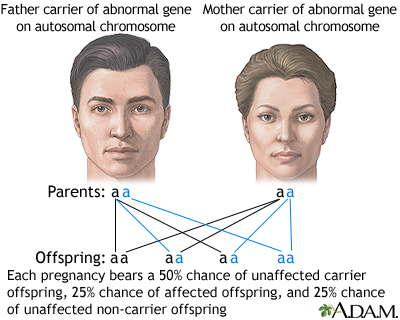Autosomal recessive
Autosomal recessive is one of several ways that a genetic trait, disorder, or disease can be passed down through families.
An autosomal recessive disorder means two copies of an abnormal gene must be present in order for the disease or trait to develop.
Gene
A gene is a short piece of DNA. Genes tell the body how to build specific proteins. There are about 20,000 genes in each cell of the human body. T...

Information
Inheriting a specific disease, condition, or trait depends on the type of chromosome that is affected. The two types are autosomal chromosomes and sex chromosomes. It also depends on whether the trait is dominant or recessive.
A variation in a gene on one of the first 22 nonsex chromosomes can lead to an autosomal disorder.
Chromosomes
Chromosomes are structures found in the center (nucleus) of cells that carry long pieces of DNA. DNA is the material that holds genes. It is the bu...

Genes come in pairs. One gene in each pair comes from the egg, and the other gene comes from the sperm. Recessive inheritance means both genes in a pair must be abnormal to cause disease. People with only one variant gene in the pair are called carriers. These people are most often not affected with the condition. However, they can pass the variant gene to their children.
CHANCES OF INHERITING A TRAIT
If you are born to parents who both carry the same autosomal recessive gene, you have a 25% (1 in 4) chance of inheriting the variant gene from both parents and developing the disease. You have a 50% (1 in 2) chance of inheriting one variant gene. This would make you a carrier.
In other words, for a child born to a couple who both carry the variant gene (but do not have signs of disease), the expected outcome for each pregnancy is:
- A 25% chance that the child is born with two normal genes (healthy)
- A 50% chance that the child is born with one normal and one variant gene (carrier, without disease)
- A 25% chance that the child is born with two variant genes (at risk for the disease)
Note: These outcomes do not mean that the children will definitely be carriers or be severely affected.
Reviewed By
Anna C. Edens Hurst, MD, MS, Associate Professor in Medical Genetics, The University of Alabama at Birmingham, Birmingham, AL. Review provided by VeriMed Healthcare Network. Also reviewed by David C. Dugdale, MD, Medical Director, Brenda Conaway, Editorial Director, and the A.D.A.M. Editorial team.
Gregg AR, Kuller JA. Human genetics and patterns of inheritance. In: Lockwood CJ, Copel JA, Dugoff L, eds. Creasy and Resnik's Maternal-Fetal Medicine: Principles and Practice. 9th ed. Philadelphia, PA: Elsevier; 2023:chap 1.
Jones KL, Jones MC, Campo M. Genetics, genetic counseling, and prevention. In: Jones KL, Jones MC, Campo MD, eds. Smith's Recognizable Patterns of Human Malformation. 8th ed. Philadelphia, PA: Elsevier; 2022:chap 2.
Korf BR, Limdi NA. Principles of genetics. In: Goldman L, Cooney KA, eds. Goldman-Cecil Medicine. 27th ed. Philadelphia, PA: Elsevier; 2024:chap 31.
Scott DA, Lee B. Patterns of genetic transmission. In: Kliegman RM, St. Geme JW, Blum NJ, et al, eds. Nelson Textbook of Pediatrics. 22nd ed. Philadelphia, PA: Elsevier; 2025:chap 97.
Sondheimer N. Patterns of single-gene inheritance. In: Cohn RD, Scherer SW, Hamosh A, eds. Thompson & Thompson Genetics and Genomics in Medicine. 9th ed. Philadelphia, PA: Elsevier; 2024:chap 7.
Disclaimer


 All rights reserved.
All rights reserved.